Year :
2005
Title :
Biology
Exam :
JAMB Exam
Paper 1 | Objectives
21 - 30 of 50 Questions
| # | Question | Ans |
|---|---|---|
| 21. |
The urinary tubules of the kidney function through A. osmosis and diffusion B. active transport and osmosis C. ultrfiltration and selective reabsorption D. active transport and cytoplasmic streaming |
C |
| 22. |
Excess water in plants is excreted as water vapour and droplets respectively through A. respiration and guttation B. transpiration and guttation C. photosynthesis and guttation D. guttation and condensation |
B |
| 23. |
When bacteria swim from cold to warm regions this is known as A. negative chemotaxis B. positive thermotaxis C. positive phototaxis D. negative phototaxis |
B |
| 24. |
Hydrostatic skeleton is the type of supporting system found in A. mammals B. reptiles C. oligochaetes D. arthropods Detailed Solution- An annelid worm of the class Oligochaeta, such as an earthworm.- The earthworm's body is also known as a hydrostatic skeleton, which is a flexible skeleton filled with fluid. |
|
| 25. |
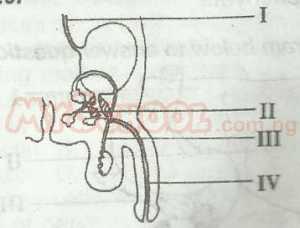 From the diagram above the structure labelled I originates from the A. liver B. kidney C. small intestine D. stomach |
B |
| 26. |
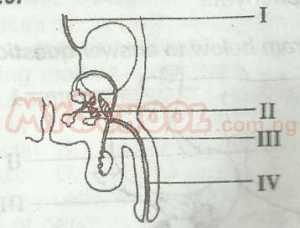 From the diagram above Birth control by vasectomy is achieved by severing the structure labelled A. I B. II C. III D. IV |
C |
| 27. |
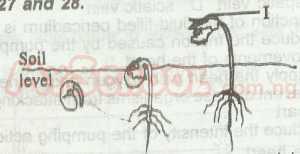 The main function of the structure labelled I is to A. store food for the young plant B. pull the young shoot above the ground C. store water for the seedling D. protect the young plumule |
D |
| 28. |
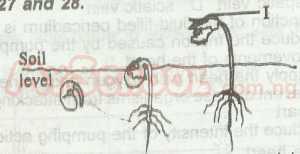 The type of germination illustrated is termed A. hypogeal B. epicotyl C. epigeal D. hypocotyl |
C |
| 29. |
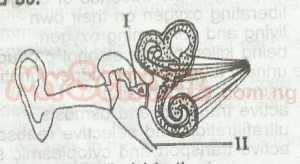 From the diagram above The structure labelled I is the A. incus B. malleus C. hammer D. stapes |
D |
| 30. |
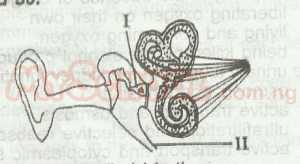 A function of the part labelled II is to A. equalize pressure on both sides of the tympanum B. conduct sound waves to the brain C. help the animal maintain balance or posture D. transform sound waves into electric impulses |
A |
| 21. |
The urinary tubules of the kidney function through A. osmosis and diffusion B. active transport and osmosis C. ultrfiltration and selective reabsorption D. active transport and cytoplasmic streaming |
C |
| 22. |
Excess water in plants is excreted as water vapour and droplets respectively through A. respiration and guttation B. transpiration and guttation C. photosynthesis and guttation D. guttation and condensation |
B |
| 23. |
When bacteria swim from cold to warm regions this is known as A. negative chemotaxis B. positive thermotaxis C. positive phototaxis D. negative phototaxis |
B |
| 24. |
Hydrostatic skeleton is the type of supporting system found in A. mammals B. reptiles C. oligochaetes D. arthropods Detailed Solution- An annelid worm of the class Oligochaeta, such as an earthworm.- The earthworm's body is also known as a hydrostatic skeleton, which is a flexible skeleton filled with fluid. |
|
| 25. |
 From the diagram above the structure labelled I originates from the A. liver B. kidney C. small intestine D. stomach |
B |
| 26. |
 From the diagram above Birth control by vasectomy is achieved by severing the structure labelled A. I B. II C. III D. IV |
C |
| 27. |
 The main function of the structure labelled I is to A. store food for the young plant B. pull the young shoot above the ground C. store water for the seedling D. protect the young plumule |
D |
| 28. |
 The type of germination illustrated is termed A. hypogeal B. epicotyl C. epigeal D. hypocotyl |
C |
| 29. |
 From the diagram above The structure labelled I is the A. incus B. malleus C. hammer D. stapes |
D |
| 30. |
 A function of the part labelled II is to A. equalize pressure on both sides of the tympanum B. conduct sound waves to the brain C. help the animal maintain balance or posture D. transform sound waves into electric impulses |
A |